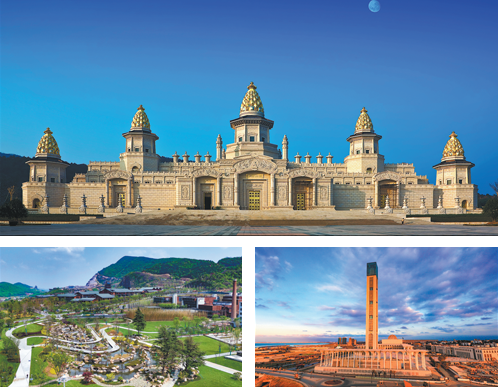Historical relics preserved for the future thanks to help from China State Construction

China State Construction Engineering Corporation Ltd, or CSCEC, and its overseas branches have contributed to protect cultural heritage in recent years.
The new Sanxingdui Museum, which is a world-class site designed and constructed by CSCEC, came into use in July 2023. The Beijing-based company used "fast speed, high quality and new technology" to display relics of the ancient Shu Kingdom.
The new building has a total construction area of about 54,400 square meters, five times that of the old one, and an exhibition area of 22,000 sq m, displaying more than 1,500 pieces or sets of cultural relics.
According to the company, construction of the new extension had a tight deadline and high-quality requirements. At the beginning of the project, it chose the path of intelligent construction to present a masterpiece in the shortest possible time.
Its construction team utilized virtual design and simulation systems as well as building information modeling to create a virtual museum first and to act as the intelligent brain for the construction phase. Based on visualization models, the team conducted digital rehearsals of the project's entire lifecycle. Specifically focusing on key solutions, construction organization and challenging aspects, they carried out comprehensive planning and revisions virtually.
The construction team also installed a constant temperature and humidity system to ensure that the artifacts are safely housed in an environment that meets their specific preservation needs. The artifacts involve materials such as ivory, jade, bronze and gold. The team also used solar power, wind energy, noise control and dust control systems to achieve green construction in the whole process.
Solving technological problems is key to implementing a design blueprint. The team set up an innovation group in the early stages and has recognized more than 10 scientific and technological challenges. Focusing on the challenges, it published 32 papers and applied for 65 patents, including 20 invention patents.
The Jiangsu horticultural expo park in Nanjing, capital of East China's Jiangsu province, is another significant project of CSCEC. The site had been rich in mineral resources and a quarrying upsurge between the 1950s and the early 2000s had left huge pits and derelict factories as remnants.
To preserve and develop its industrial heritage, the project team reinforced and renovated abandoned production lines and silos of a cement plant, revitalizing the original 30,000 sq m relic as a distinctive feature. By improving the damaged original landforms, it ensured the presentation of a green landscape and created a garden in a pit.
The project integrates various formats such as ancient architecture, garden landscapes, urban facilities and ecological improvement. It hosted the 11th Jiangsu Horticultural Expo in April 2021.
Overseas operations
The Great Mosque of Algiers in Algeria, which was constructed by CSCEC, reached internationally leading levels in terms of integrated design and construction technology in an evaluation of scientific and technological achievements in July 2020. Ding Lieyun, an academician at the Chinese Academy of Engineering, was leader of the evaluation team.
The mosque covers an area of 400,000 sq m, the third-largest in the world and features a minaret with a height of 265 meters. As a symbolic project of the Belt and Road Initiative, it strengthened the friendship between China and Algeria and set an example of Chinese enterprises "going abroad", according to CSCEC.
To better integrate cultural elements into the architectural design, the construction team learned much about Algerian history, designed things such as gypsum carvings, hand-painted tiles and stone mosaic patterns based on Islamic traditional decorative patterns. It also combined handmade techniques with modern craftsmanship to complete the religious decorations of the building, conveying the friendliness and harmony of Islam, according to the company. The project has been granted 18 patents, including six invention patents, and 21 papers have been published.
Members of the Malaysian branch of CSCEC participated as World Heritage Volunteers of UNESCO to protect architectural heritage in Malacca in July 2023 with participants from six countries. The branch's volunteers were mainly involved in the opening ceremony, in forums with heritage experts and the inspection and restoration of historical buildings at the volunteer camp.
Tan Ta Sen, head of Cheng Ho Cultural Museum, expressed thanks to companies, including CSCEC, which supported and helped the protection of architectural heritage.
Malacca is a city with a rich history and culture dating back more than 600 years. Zheng He's maritime voyages left historical footprints in Malacca, making it an important part of the Maritime Silk Road economic belt, Tan said. He hopes people can learn about the history and culture of Malacca by exploring ancient buildings.
The company's volunteers conducted measurements, load-bearing assessments, cleaning and maintenance work at Zheng He Tea House in the ancient site area of Malacca.
WHV's global project director said in a letter that it was gratifying that CSCEC, as a Fortune Global 500 company, participated in a volunteer project in the world heritage field.
He added that he hoped to engage in global cooperation with CSCEC to transmit heritage protection concepts to the next generation in the Asia-Pacific and Indian Ocean regions.
As early as 2006, CSCEC undertook its first cultural tourism project, the Brahma Palace in Wuxi city's Lingshan Buddhist Scenic Spot. Its architectural form breaks with tradition, primarily using durable materials such as stone. It extensively incorporates tall columns, large-span beams and pillars, soaring domes, and expansive halls, showcasing the profound and sublime nature of Buddhism while blending traditional cultural elements with contemporary characteristics.
CSCEC has undertaken other building projects to aid in the protection of cultural heritage. These include the Xi'an branch of the China National Archives of Publications and Culture in Northwest China's Shaanxi province and a Great Wall intangible cultural heritage exhibition hall in the Ningxia Hui autonomous region, which is also in Northwest China.

Today's Top News
- China's industrial profits down 1.8% in H1
- Thailand responds to Trump's ceasefire call
- Recall vote shows DPP's manipulation runs against Taiwan people's will: mainland spokesperson
- Top DPRK leader visits China-DPRK Friendship Tower
- China proposes global cooperation body on AI
- Scholars propose inclusive human rights framework






























